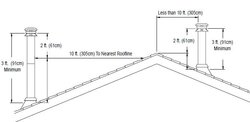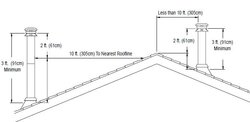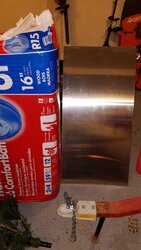what an American hero. Should i hire an inspector for this thing? HomeinPA got me all freaked outExactly!
Flue damper, what's it for?
- Thread starter FR9Ford
- Start date
-
Active since 1995, Hearth.com is THE place on the internet for free information and advice about wood stoves, pellet stoves and other energy saving equipment.
We strive to provide opinions, articles, discussions and history related to Hearth Products and in a more general sense, energy issues.
We promote the EFFICIENT, RESPONSIBLE, CLEAN and SAFE use of all fuels, whether renewable or fossil.
You are using an out of date browser. It may not display this or other websites correctly.
You should upgrade or use an alternative browser.
You should upgrade or use an alternative browser.
Jan Pijpelink
Minister of Fire
what an American hero. Should i hire an inspector for this thing? HomeinPA got me all freaked out
You can do it yourself. I did it 2 years ago and it made a huge difference. As like you I was and still am in a learning curve, thanks to this site.
Im talking to inspect the install. Someone had said that the install wasnt code?You can do it yourself. I did it 2 years ago and it made a huge difference. As like you I was and still am in a learning curve, thanks to this site.
Jan Pijpelink
Minister of Fire
Im talking to inspect the install. Someone had said that the install wasnt code?
If you have any doubts about the install itself, ask an installer (not the one you worked with before) and ask what he/she thinks. However, the addition of the chimney is a no-brainer IMO.
Alrighty, thanksIf you have any doubts about the install itself, ask an installer (not the one you worked with before) and ask what he/she thinks. However, the addition of the chimney is a no-brainer IMO.

Jan Pijpelink
Minister of Fire
Alrighty, thanks
On one of my stoves I noticed poor draft. I checked the Class A chimney and it was a foot below the roof top (I was a newbie). I added a section of 4 feet and oh what a difference. Stove performs so much better. Recommendation (on this site) is to have the pipe 4 feet above the highest point on the roof.
So, roxul insulation, block off plate, roxul board and chimney. Whew I gots me a project this saturdayOn one of my stoves I noticed poor draft. I checked the Class A chimney and it was a foot below the roof top (I was a newbie). I added a section of 4 feet and oh what a difference. Stove performs so much better.
Jan Pijpelink
Minister of Fire
So, roxul insulation, block off plate, roxul board and chimney. Whew I gots me a project this saturday
On Sunday you will be glad you did it.
Just to be clear, the code is not for the chimney to be x # of feet above the highest peak of the roof. This image shows the height requirement.
This is not a draft issue. It is a heat loss issue. Imagine how warm that masonry gets after 4 hours of run time. I bet 2 hours is not enough for everything to equalize. It probably gets another 5 or 10 degrees warmer. That is a huge thermal mass sucking the heat out of the back of the stove.
This is not a draft issue. It is a heat loss issue. Imagine how warm that masonry gets after 4 hours of run time. I bet 2 hours is not enough for everything to equalize. It probably gets another 5 or 10 degrees warmer. That is a huge thermal mass sucking the heat out of the back of the stove.
Attachments
Bootstrap
Burning Hunk
WAIT A MINUTE.... You're outside....you have a stone chase around the firebox and they converted to a class A and then went through the roof or overhang??? Did the stuff a flexible stainless liner inside the class A?? Am I missing something here??? Is that a prefab fireplace? Something is amiss here.
It definitely doesn't look like a prefab.
HomeinPA
Minister of Fire
"Technically" it's 2' higher than anything within 10' and 3' through above the roofline on the lower side of the chimney. That's the minimum required by code. There is also the concept of making sure the chimney vents above the thermal envelope of the structure. 4-5 feet above the roof doesn't hurt though
Bootstrap
Burning Hunk
Your house is too tight then. As mentioned, make up air is needed.Wow. I opened a window 30 feet from the stove. Instant fire and i can feel wind in the living room
Then i think technically it's ok?"Technically" it's 2' higher than anything within 10' and 3' through above the roofline on the lower side of the chimney. That's the minimum required by code. There is also the concept of making sure the chimney vents above the thermal envelope of the structure. 4-5 feet above the roof doesn't hurt though
Sorry, i don't see anything by weeby when searchingHere is the rule for chimney height relative to the roof.
View attachment 220387
Roxul batt insulation is fine, it doesn't need to be Roxul board. Note webby's installation for reference.
Sprinter
Minister of Fire
Your house is too tight then. As mentioned, make up air is needed.
Are we starting over? This was discussed many pages ago. At this point, though, I'm just listening.
Lol, it's burning fine. I insulated the chit out of it, and it's kickin arse. Storm blew in last night and my tarp was in the woods, so my woods a wee wet. But it seems to be burning fine. Cruising about 75* less than normal but burn times are up, the house is actually warm. I think I'm doing good.Are we starting over? This was discussed many pages ago. At this point, though, I'm just listening.
Easy Livin’ 3000
Minister of Fire
I just read through both of your recent threads. Now I'm exhausted. You finally got your answer, but they sure made you work for it.Lol, it's burning fine. I insulated the chit out of it, and it's kickin arse. Storm blew in last night and my tarp was in the woods, so my woods a wee wet. But it seems to be burning fine. Cruising about 75* less than normal but burn times are up, the house is actually warm. I think I'm doing good.
The picture that you took up into your chimney tells the whole story. Heat rises, and until you stopped up that giant hole, you just had another chimney that was effectively venting the heat up into the chimney and warming the masonry. This was a simple problem with a simple solution. And, my educated guess is that it is the same problem plagues 90+% of insert installs.
Every "insert is not heating" question should be answered with the block off plate/insulation solution first.
I learned a lot though. And I had absolutely no clue what I was doing. I eventually would of got mad enough I woulda sold the stove probably lolI just read through both of your recent threads. Now I'm exhausted. You finally got your answer, but they sure made you work for it.
The picture that you took up into your chimney tells the whole story. Heat rises, and until you stopped up that giant hole, you just had another chimney that was effectively venting the heat up into the chimney and warming the masonry. This was a simple problem with a simple solution. And, my educated guess is that it is the same problem plagues 90+% of insert installs.
Every "insert is not heating" question should be answered with the block off plate/insulation solution first.
Easy Livin’ 3000
Minister of Fire
Unfortunately I think you learned a bunch of bad or marginal lessons along the way. Glad you stuck with it, it can be frustrating to sift through it all, and $7k is no small investment. I'm still working through it myself, but at least now I know the problems, just up to me to get em fixed. Stay warm!I learned a lot though. And I had absolutely no clue what I was doing. I eventually would of got mad enough I woulda sold the stove probably lol
What do you mean bad lessons?Unfortunately I think you learned a bunch of bad or marginal lessons along the way. Glad you stuck with it, it can be frustrating to sift through it all, and $7k is no small investment. I'm still working through it myself, but at least now I know the problems, just up to me to get em fixed. Stay warm!
Sprinter
Minister of Fire
Sprinter
Minister of Fire
Similar threads
- Replies
- 1
- Views
- 197
- Replies
- 44
- Views
- 2K
- Replies
- 6
- Views
- 815
- Replies
- 9
- Views
- 1K





